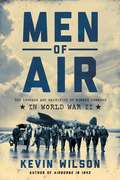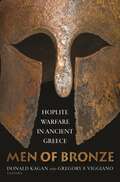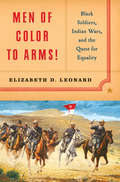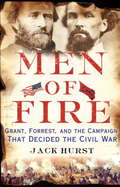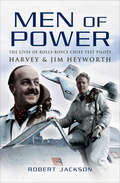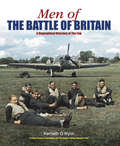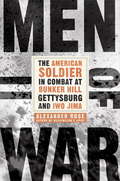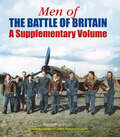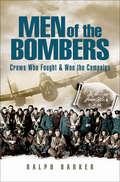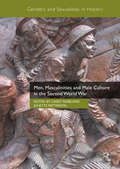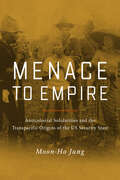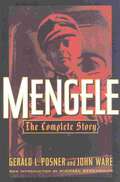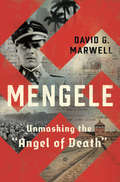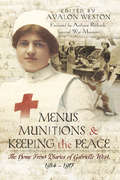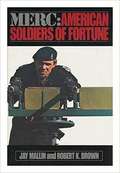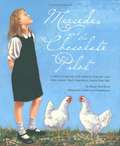- Table View
- List View
Men of Air: The Courage And Sacrifice Of Bomber Command In World War Ii
by Kevin WilsonThe story of the everyday heroism of bomber crews in 1944, a turning point in the war against Germany. Bomber combat crews faced a wide array of perils as they flew over German territory. Bursts of heavy flak could tear the wings from their planes in a split second. Flaming bullets from German fighter planes could explode their fuel tanks, cut their oxygen supplies, destroy their engines. Thousands of young men were shot, blown up, or thrown from their planes five miles above the earth; and even those who returned faced the subtler dangers of ice and fog as they tried to land their battered aircraft back home. The winter of 1944 was the most dangerous time to be a combat airman in RAF Bomber Command. The chances of surviving a tour were as low as one in five, and morale had finally hit rock bottom. In this comprehensive history of the air war that year, Kevin Wilson describes the most dangerous period of the Battle of Berlin, and the unparalleled losses over Magdeburg, Leipzig and Nuremberg. Men of Air reveals how these ordinary men coped with the extraordinary pressure of flying, the loss of their colleagues, and the threat of death or capture. Brilliantly placing these stories within the context of The Great Escape, D-Day, the defeat of the V1 menace, and more, Wilson shows how the sheer grit and determination of these "Men of Air" finally turned the tide against the Germans.
Men of Barbarossa: Commanders of the German Invasion of Russia, 1941
by Samuel W. Mitcham Jr.&“&‘A must read&’ for Eastern Front fans, as well as anyone seeking to find out more about the titanic struggle between Hitler and Stalin.&” —Armchair General This book not only tells the story of Operation Barbarossa, the German invasion of the Soviet Union, but describes the expertise, skills, and decision-making powers of the men who directed it, including new insights into the invasion&’s many tactical successes, as well as its ultimate failure. This objective is massive in scope, because Operation Barbarossa was massive in scale, arguably the largest military operation of all time. The campaign also changed the world forever. Before Barbarossa, Hitler&’s Wehrmacht seemed invincible, like an unstoppable force of nature. No one, it seemed, could check the Führer&’s ambitions, much less defeat him. Barbarossa changed all of that. By the end of 1941, Allied victory seemed to be a very real possibility. Few would have bet on it sixteen or seventeen months earlier. Pitting Germany in total war against the Soviet Union on a 1,000-mile front, Operation Barbarossa was truly staggering in its magnitude. Wars, however, are not fought by numbers, they are fought by men. In this book we learn of the villains and heroes, famous commanders and unsung leaders, and about those who were willing to stand up to the Führer and those who subordinated themselves to his will. The result is a book that casts a fresh perspective on one of history&’s most crucial military campaigns.
Men of Bronze: Hoplite Warfare in Ancient Greece
by Donald Kagan and Gregory F. ViggianoA major contribution to the debate over ancient Greek warfare by some of the world's leading scholarsMen of Bronze takes up one of the most important and fiercely debated subjects in ancient history and classics: how did archaic Greek hoplites fight, and what role, if any, did hoplite warfare play in shaping the Greek polis? In the nineteenth century, George Grote argued that the phalanx battle formation of the hoplite farmer citizen-soldier was the driving force behind a revolution in Greek social, political, and cultural institutions. Throughout the twentieth century scholars developed and refined this grand hoplite narrative with the help of archaeology. But over the past thirty years scholars have criticized nearly every major tenet of this orthodoxy. Indeed, the revisionists have persuaded many specialists that the evidence demands a new interpretation of the hoplite narrative and a rewriting of early Greek history. Men of Bronze gathers leading scholars to advance the current debate and bring it to a broader audience of ancient historians, classicists, archaeologists, and general readers.After explaining the historical context and significance of the hoplite question, the book assesses and pushes forward the debate over the traditional hoplite narrative and demonstrates why it is at a crucial turning point. Instead of reaching a consensus, the contributors have sharpened their differences, providing new evidence, explanations, and theories about the origin, nature, strategy, and tactics of the hoplite phalanx and its effect on Greek culture and the rise of the polis.The contributors include Paul Cartledge, Lin Foxhall, John Hale, Victor Davis Hanson, Donald Kagan, Peter Krentz, Kurt Raaflaub, Adam Schwartz, Anthony Snodgrass, Hans van Wees, and Gregory Viggiano.
Men of Capital: Scarcity and Economy in Mandate Palestine
by Sherene SeikalyMen of Capital examines British-ruled Palestine in the 1930s and 1940s through a focus on economy. In a departure from the expected histories of Palestine, this book illuminates dynamic class constructions that aimed to shape a pan-Arab utopia in terms of free trade, profit accumulation, and private property. And in so doing, it positions Palestine and Palestinians in the larger world of Arab thought and social life, moving attention away from the limiting debates of Zionist-Palestinian conflict. Reading Palestinian business periodicals, records, and correspondence, Sherene Seikaly reveals how capital accumulation was central to the conception of the ideal "social man. " Here we meet a diverse set of characters--the man of capital, the frugal wife, the law-abiding Bedouin, the unemployed youth, and the abundant farmer--in new spaces like the black market, cafes and cinemas, and the idyllic Arab home. Seikaly also traces how British colonial institutions and policies regulated wartime austerity regimes, mapping the shortages of basic goods--such as the vegetable crisis of 1940--to the broader material disparities among Palestinians and European Jews. Ultimately, she shows that the economic is as central to social management as the political, and that an exclusive focus on national claims and conflicts hides the more complex changes of social life in Palestine.
Men of Color to Arms!: Black Soldiers, Indian Wars, and the Quest for Equality
by Elizabeth D. LeonardThe story of the black soldiers who helped save the Union, conquer the West, and build the nation. In 1863, at the height of the Civil War, Frederick Douglass promised African Americans that serving in the military offered a sure path to freedom. Once a black man became a soldier, Douglass declared, "there is no power on earth or under the earth which can deny that he has earned the right to citizenship in the United States." More than 180,000 black men heeded his call to defend the Union--only to find the path to equality would not be so straightforward. In this sharply drawn history, Professor Elizabeth D. Leonard reveals the aspirations and achievements as well as the setbacks and disappointments of African American soldiers. Drawing on eye-opening firsthand accounts, she restores black soldiers to their place in the arc of American history, from the Civil War and its promise of freedom until the dawn of the 20th century and the full retrenchment of Jim Crow. Along the way, Leonard offers a nuanced account of black soldiers' involvement in the Indian Wars, their attempts to desegregate West Point and gain proper recognition for their service, and their experience of Reconstruction nationally, as blacks worked to secure their place in an ever-changing nation. With abundant primary research, enlivened by memorable characters and vivid descriptions of army life, Men of Color to Arms! is an illuminating portrait of a group of men whose contributions to American history need to be further recognized.
Men of Fire: Grant, Forrest, and the Campaign That Decided the Civil War
by Jack HurstDeep in the winter of 1862, on the border between Kentucky and Tennessee, two extraordinary military leaders faced each other in an epic clash that would transform them both and change the course of American history forever. Brigadier General Ulysses S. Grant had no significant military successes to his credit at the outset of the campaign. He was barely clinging to his position within the Union Army--he had been officially charged with chronic drunkenness only days earlier, and his own troops despised him. His opponent was as untested as he was: an obscure lieutenant colonel named Nathan Bedford Forrest. The two men held one thing in common: an unrelenting desire for victory at any cost. A riveting account of the making of two great military leaders, and two battles that transformed America forever, Men of Fire is destined to become a classic work of military history.
Men of Power: The Lives of Rolls-Royce Chief Test Pilots Harvey & Jim Heyworth
by Robert JacksonThe story begins in 1940 when Harvey Heyworth was leading No. 79 Squadron RAF defending north-eastern England from Luftwaffe raids made by bombers based in Norway and Denmark and then later in the Battle of Britain when the unit moved south. During late 1940 and up to June 1941 Heyworth led his squadron in defense of Bristol and Swansea operating by night and day. By 1942 he had amassed 4,000 flying hours. Harvey then joined Rolls-Royce test flying early British jet aircraft including the famous Gloster-Whittle and test-bed Wellington bombers powered by the new jet engines.In 1944 Harvey's brother Jim also joined Rolls, having flown with No. 12 Squadron in Bomber Command. The story then unfolds into the development of the Trent turboprop and the Avon jet engines. Development work on a variety of test-bed aircraft was ongoing and included some weird combinations of airframe and engine.Jim succeeded his brother as chief test pilot in 1958 and flew 82 different aircraft types. He recounts his experiences of piloting the Vulcan bomber, Lightning and the 'Flying Bedstead' VTOL test rig.
Men of The Battle of Britain: A Biographical Dictionary of the Few
by Kenneth G. WynnSince it was first published in 1989, Men of the Battle of Britain has become a standard reference book for academics and researchers interested in the Battle of Britain. Copies are also owned by many with purely an armchair interest in the events of 1940.The book records the service details of the airmen who took part in the Battle of Britain in considerable detail. Where known, postings and their dates are included, as well as promotions, decorations and successes claimed flying against the enemy. There is also much personal detail, often including dates and places of birth, civilian occupations, dates of death and place of burial or, for those with no known grave, place of commemoration. There are many wartime head-and-shoulders photographs. Inevitably the high achievers who survived tend to have the longest entries, but those who were killed very quickly, sometimes even on their first sortie, are given equal status.The 2015 third edition will include new names and corrected spellings, as well as many new photographs. Plenty of the entries have been extended with freshly acquired information. The stated nationalities of some of the airmen have been re-examined and, for example, one man always considered to be Australian is now known to have been Irish.
Men of Valour: New Zealand And The Battle For Crete
by Ron PalenskiIn May of 1941 New Zealand?s citizen soldiers, not long removed from their day jobs, were thrust into a type of fighting the world had not seen before: a land force against an airborne invasion. It was man against machines. In many ways, Crete became in the Second World War what Gallipoli had been in the First: another Dunkirk ? a scrambling effort to survive after defeat. This book breathes new life into the baptism of fire for New Zealand?s men of valour. It puts a human face on a military disaster, a failure that paradoxically was as large for the victors, the Germans, as it was for the losers, the Allies, among whom New Zealanders dominated. Crete tempered the New Zealand Division, and it went on to become one of the most respected and admired fighting forces of the Second World War.
Men of War
by Alexander RoseIn the grand tradition of John Keegan's enduring classic The Face of Battle comes a searing, unforgettable chronicle of war through the eyes of the American soldiers who fought in three of our most iconic battles: Bunker Hill, Gettysburg, and Iwo Jima. This is not a book about how great generals won their battles, nor is it a study in grand strategy. Men of War is instead a riveting, visceral, and astonishingly original look at ordinary soldiers under fire. Drawing on an immense range of firsthand sources from the battlefield, Rose begins by re-creating the lost and alien world of eighteenth-century warfare at Bunker Hill, the bloodiest clash of the War of Independence--and reveals why the American militiamen were so lethally effective against the oncoming waves of British troops. Then, focusing on Gettysburg, Rose describes a typical Civil War infantry action, vividly explaining what Union and Confederate soldiers experienced before, during, and after combat. Finally, he shows how in 1945 the Marine Corps hurled itself with the greatest possible violence at the island of Iwo Jima, where nearly a third of all Marines killed in World War II would die. As Rose demonstrates, the most important factor in any battle is the human one: At Bunker Hill, Gettysburg, and Iwo Jima, the American soldier, as much as any general, proved decisive. To an unprecedented degree, Men of War brings home the reality of combat and, just as important, its aftermath in the form of the psychological and medical effects on veterans. As such, the book makes a critical contribution to military history by narrowing the colossal gulf between the popular understanding of wars and the experiences of the soldiers who fight them.Advance praise for Men of War "A brilliant, riveting, unique book, Men of War does for the American soldier what John Keegan's The Face of Battle did for the British soldier. Using three epochal battles--Bunker Hill, Gettysburg, and Iwo Jima--Alexander Rose takes us into the ranks and helps us understand the experiences of those fighting on the ground. He captures vividly the emotions and conditions of combat--the terror and the boredom, the barbarity and the magnanimity--helping readers understand the realities known to those who have earned membership in that most treasured of fraternities, the brotherhood of the close fight. Men of War will be a classic."--General David H. Petraeus, U.S. Army (Retired) "On the model of The Face of Battle, Alexander Rose has applied the same technique of description and analysis to three landmark battles in American history. The overwhelming experience of combat for front-line soldiers who lived to write about it, and through their eyes those who did not, comes through with stark realism. If you want to know the meaning of war at the sharp end, this is the book to read."--James McPherson, Pulitzer Prize-winning author of The War That Forged a Nation "Alexander Rose tells us about war from the perspective of those who fought it, capturing myriad combat details to weave a gripping tapestry of three of the most iconic battles in U.S. history--Bunker Hill, Gettysburg, and Iwo Jima."--Robert L. O'Connell, author of Fierce Patriot "A highly recommended addition to the literature of military history . . . Rose builds up a detailed picture of each of these battles, sparing few gritty details and romanticizing almost nothing. He writes vividly and memorably, with a good eye for the telling detail or anecdote as well as big-picture perspectives."--Kirkus Reviews (starred review)From the Hardcover edition.
Men of the Battle of Britain: A Supplementary Volume
by Kenneth G. Wynn“Tells about various details of data, squadrons, training, life path, passport photos and more. This supplement contains addition for about 350(!) airmen.” —Aviation Book ReviewsSince it was first published in 1989, Men of the Battle of Britain, the complete third edition of which was published in 2015, has become a standard reference book for academics and researchers interested in the Battle of Britain. This remarkable publication records the service details of every airman who took part in the Battle of Britain, and who earned the Battle of Britain Clasp, in considerable detail. Where known, an individual’s various postings and their dates are included, as are promotions, decorations, and successes claimed while flying against the enemy. There is also much personal detail, often including dates and places of birth, civilian occupations, dates of death and place of burial or, for those with no known grave, place of commemoration. There are many wartime head-and-shoulders photographs.Inevitably, the passage of time ensures that there is a constant reevaluation of the wealth of information contained within Men of the Battle of Britain. At the same time, since the 2015 edition it has been possible to expand many individual entries, some 330 in total, to give some idea of the wider social context around the aircrew who earned the Battle of Britain Clasp. This has been achieved by reference to existing sources, including information supplied by The Few themselves and their relatives over many years, as well as new research.This invaluable supplement to the 2015 edition ensures that these additions and revisions are available to all researchers, historians, enthusiasts and general readers.
Men of the Bombers: Crews Who Fought & Won the Campaign (Reminiscence Ser.)
by Ralph BarkerThis is a selection of ten remarkable true accounts of unusual incidents and happenings to Bomber Command aircrew during World War Two. It covers operations of varying natures, such as one of the first leaflet dropping raids during the 'Phoney War' when the elderly Whitley bomber proved to be a nightmare on long flights and when the crews suffered more from lack of oxygen and heating than from enemy action. The fascinating story of a famous MP who used his influence to become a tail gunner at the age of 55 and who lost his life trying to stop German Panzers before Dunkirk proves remarkable reading and a famous name in cricket, Bill Edrich, recounts his days flying low-level daylight raids in Bristol Blenheims during 1941. Then there is a young New Zealander, Jimmy Ward, who climbed out onto a Wellington bomber's wing at considerable altitude to extinguish an engine fire and how despite his own modesty he was awarded a VC. Other stories tell of amazing escapes from burning aircraft, the heroism of aircrew who sacrificed their own lives so that others may survive and how a mid-upper gunner took the controls of a Mitchell B-25 to pilot her safely home.
Men, Masculinities and Male Culture in the Second World War
by Juliette Pattinson Linsey RobbThis edited collection brings together cutting-edge research on British masculinities and male culture, considering the myriad ways British men experienced, understood and remembered their exploits during the Second World War, as active combatants, prisoners and as civilian workers. It examines male identities, roles and representations in the armed forces, with particular focus on the RAF, army, volunteers for dangerous duties and prisoners of war, and on the home front, with case studies of reserved occupations and Bletchley Park, and examines the ways such roles have been remembered in post-war years in memoirs, film and memorials. As such this analysis of previously underexplored male experiences makes a major contribution to the historiography of Britain in the Second World War, as well as to socio-cultural history, cultural studies and gender studies.
Men-of-War: Life in Nelson's Navy
by Patrick O'BrianA concise overview, richly illustrated, of the historical background to the acclaimed Aubrey/Maturin novels. This book is a companion to Patrick O'Brian's sea novels, a straightforward exploration of what daily life in Nelson's navy was really like, for everyone from the captain down to the rawest recruit. What did they eat? What songs did they sing? What was the schedule of watches? How were the officers and crew paid, and what was the division of prize-money? These questions and many more are answered in Patrick O'Brian's elegant narrative, which includes wonderful anecdotal material on the battles and commanders that established Britain's naval supremacy. Line drawings and charts help us to understand the construction and rigging of the great ships, the types and disposition of the guns, and how they were operated in battle. A number of contemporary drawings and cartoons illustrate aspects of naval life from the press gang to the scullery. Finally, a generous selection of full-color paintings render the majesty and the excitement of fleet actions in the age of fighting sail.
Menace to Empire: Anticolonial Solidarities and the Transpacific Origins of the US Security State (American Crossroads #63)
by Moon-Ho JungThis history reveals how radical threats to the United States empire became seditious threats to national security and exposes the antiradical and colonial origins of anti-Asian racism. Menace to Empire transforms familiar themes in American history. This profoundly ambitious history of race and empire traces both the colonial violence and the anticolonial rage that the United States spread across the Pacific between the Philippine-American War and World War II. Moon-Ho Jung argues that the US national security state as we know it was born out of attempts to repress and silence anticolonial subjects, from the Philippines and Hawaiʻi to California and beyond. Jung examines how various revolutionary movements spanning the Pacific confronted the US empire. In response, the US state closely monitored and brutally suppressed those movements, exaggerating fears of pan-Asian solidarities and sowing anti-Asian racism. Radicalized by their opposition to the US empire and racialized as threats to US security, peoples in and from Asia pursued a revolutionary politics that engendered and haunted the national security state—the heart and soul of the US empire ever since.
Mengele: The Complete Story
by John Ware Gerald L. PosnerBased on exclusive and unrestricted access to more than 5,000 pages of personal writings and family photos, this definitive biography of German physician and SS-Hauptsturmfuhrer Josef Mengele (1911-1979) probes the personality and motivations of Auschwitz's "Angel of Death." From May 1943 through January 1945, Mengele selected who would be gassed immediately, who would be worked to death, and who would serve as involuntary guinea pigs for his spurious and ghastly human experiments (twins were Mengele's particular obsession). With authority and insight, Mengele examines the entire life of the world's most infamous doctor.
Mengele: Unmasking The Angel Of Death
by David G. MarwellA gripping biography of the infamous Nazi doctor, from a former Justice Department official tasked with uncovering his fate. Perhaps the most notorious war criminal of all time, Josef Mengele was the embodiment of bloodless efficiency and passionate devotion to a grotesque worldview. Aided by the role he has assumed in works of popular culture, Mengele has come to symbolize the Holocaust itself as well as the failure of justice that allowed countless Nazi murderers and their accomplices to escape justice. Whether as the demonic doctor who directed mass killings or the elusive fugitive who escaped capture, Mengele has loomed so large that even with conclusive proof, many refused to believe that he had died. As chief of investigative research at the Justice Department’s Office of Special Investigations in the 1980s, David G. Marwell worked on the Mengele case, interviewing his victims, visiting the scenes of his crimes, and ultimately holding his bones in his hands. Drawing on his own experience as well as new scholarship and sources, Marwell examines in scrupulous detail Mengele’s life and career. He chronicles Mengele’s university studies, which led to two PhDs and a promising career as a scientist; his wartime service both in frontline combat and at Auschwitz, where his “selections” sent innumerable innocents to their deaths and his “scientific” pursuits—including his studies of twins and eye color—traumatized or killed countless more; and his postwar flight from Europe and refuge in South America. Mengele describes the international search for the Nazi doctor in 1985 that ended in a cemetery in Sao Paulo, Brazil, and the dogged forensic investigation that produced overwhelming evidence that Mengele had died—but failed to convince those who, arguably, most wanted him dead. This is the riveting story of science without limits, escape without freedom, and resolution without justice.
Menin Gate North: In Memory and In Mourning (In Memory and in Mourning)
by Paul ChapmanThis is a comprehensive and highly emotive volume, borne of years of intensive research and many trips to the battlefields of the Great War. It seeks to humanize the Menin Gate Memorial (North), to offer the reader a chance to engage with the personal stories of the soldiers whose names have been chiseled there in stone. Poignant stories of camaraderie, tragic twists of fate and noble sacrifice have been collated in an attempt to bring home the reality of war and the true extent of its tragic cost. It is hoped that visitors to the battlefields, whether their relatives are listed within or not, will find their experience enriched by having access to this treasure trove of stories.
Menin Gate South: In Memory and In Mourning (In Memory and in Mourning)
by Paul ChapmanThis is a comprehensive and highly emotive volume, borne of years of intensive research and many trips to the battlefields of the Great War. It seeks to humanise the Menin Gate Memorial (South), to offer the reader a chance to engage with the personal stories of the soldiers whose names have been chiseled there in stone. Poignant stories of camaraderie, tragic twists of fate and noble sacrifice have been collated in an attempt to bring home the reality of war and the true extent of its tragic cost. It is hoped that visitors to the battlefields, whether their relatives are listed within or not, will find their experience enriched by having access to this treasure trove of stories.
Mensaje de Nam (Jet/debolsillo Ser. #Vol. 245)
by Danielle SteelUn inolvidable poema de amor y fidelidad. El asesinato del presidente Kennedy y los acontecimientos subsiguientes irrumpen con violencia en la vida de Paxton Andrews, una joven de Georgia marcada por la trágica pérdida de sus seres más queridos: su padre, cuando apenas era una niña, y su novio Peter. La insoportable angustia que ha de sufrir tras la muerte de este, a los pocos días de llegar a su destino en Vietnam, la reafirma en su idea de viajar a aquel país para desarrollar su carrera como periodista y trata de comprender la desaparición de Peter. A partir de aquí su vida toma un nuevo rumbo; todas las cosas adquieren un nuevo sentido que transforma a aquella joven en una mujer adulta capaz de resistir los estragos más terribles de una guerra.
Mentor Graham: The Man Who Taught Lincoln
by Kunigunde Duncan D F NickolsDiscover the remarkable story of Mentor Graham, the influential educator who played a crucial role in shaping the mind of one of America's greatest presidents, Abraham Lincoln. In Mentor Graham: The Man Who Taught Lincoln, authors Kunigunde Duncan and John W. Nickols (writing under the pseudonym William Edward Barton) provide an in-depth look at the life and legacy of the man behind the legend.This meticulously researched biography delves into the early years of Abraham Lincoln's life, focusing on his formative education under the guidance of Mentor Graham. Graham, a dedicated and innovative teacher in the small frontier town of New Salem, Illinois, recognized Lincoln's potential and nurtured his intellectual growth. Through engaging narrative and historical context, Duncan and Nickols highlight how Graham's teaching methods and mentorship helped Lincoln develop the critical thinking skills, eloquence, and knowledge that would later define his leadership.This book is an essential read for history enthusiasts, educators, and anyone interested in the untold stories behind Abraham Lincoln's rise to greatness. Duncan and Nickols' compelling narrative brings to life the enduring influence of Mentor Graham, emphasizing the profound and lasting impact that a dedicated teacher can have on the course of history.Join Kunigunde Duncan and John W. Nickols in uncovering the story of Mentor Graham and gain a deeper understanding of the man who helped forge the character and intellect of one of America's most revered leaders. Mentor Graham: The Man Who Taught Lincoln is a testament to the power of education and mentorship in shaping the future.
Menus, Munitions and Keeping the Peace: The Home Front Diaries of Gabrielle West 1914–1917
by Avalon WestonWhen Gabrielle West wrote diaries about her war to send to her much missed favorite brother in India she had no idea that a hundred years later they would be of interest to anyone.Soon after the outbreak of the First World War, Vicars daughter Gabrielle joined the Red Cross and worked as a volunteer cook in two army convalescent hospitals. She then secured paid positions in the canteens of the Farnborough Royal Aircraft Factory and then the Woolwich Arsenal, where she watched Zeppelin raids over London during her night shifts. Having failed a mental arithmetic test to drive a horse-drawn bread van for J. Lyons, she was among the first women enrolled in the police and spent the rest of the war looking after the girls in various munitions factories.Gabrielle wrote about and drew what she saw. She had no interest in opinion or politics. She took her bicycle and her dog Rip everywhere and they appear in many of her stories. She had a sharp eye and sometimes a sharp pen.At the end of the war she was simply sent home. She spent the rest of her life caring for relatives. She lived to 100 and never married. The First World War was her big adventure.These days, the reader might feel MI5 should worry about those detailed line drawings of the processes in the factories being sent by Royal Mail across the world but a hundred years ago?
Merc: American Soldiers Fortune
by MallinProfiles the character and motivation of the American mercenary soldiers-adventurers, former Green Berets and other Vietnam-era soldiers, and ex-CIA agents--who sell their military experience and expertise
Mercedes and the Chocolate Pilot: A True Story of the Berlin Airlift and the Candy that Dropped from the Sky
by Margot Theis RavenA True Story of the Berlin Airlift and the Candy that Dropped from the Sky. Life was grim in 1948 West Berlin, Germany. Josef Stalin blockaded all ground routes coming in and out of Berlin to cut off West Berliners from all food and essential supplies. Without outside help, over 2.2 million people would die. Thus began the Berlin Airlift, a humanitarian rescue mission that utilized British and American airplanes and pilots to fly in needed supplies. As one of the American pilots participating in the Airlift mission, Lt. Gail S. Halvorsen helped to provide not only nourishment to the children but also gave them a reason to hope for a better world. From one thoughtful, generous act came a lifelong relationship between Lt. Gail and the children of Berlin. This is the true story of a seven-year-old girl named Mercedes who lived in West Berlin during the Airlift and of the American who came to be known as the Chocolate Pilot. Artist Gijsbert van Frankenhuyzen's evocative paintings illuminate Margot Theis Raven's powerful story of hope, friendship and remembrance. <P><P> About the Author: Margot Theis Raven has been a professional writer working in the fields of radio, television, magazines, newspapers, and children's books for thirty years. She has won five national awards, including an IRA Teacher's Choice award. Ms. Raven earned her degree in English from Rosemont College and attended Villanova University for theater study, and Kent State University for German language. Ms. Raven splits her time living in Concord, MA, Charleston, SC and West Chesterfield, NH. About the Illustrator: Born in the Netherlands, Gijsbert van Frankenhuyzen studied at the Royal Academy of Arts in Holland. He immigrated to the United States in 1976, and years later he became a children's book illustrator. Mercedes and the Chocolate Pilot is Nick's ninth children's book with Sleeping Bear Press.
Mercenaries and Security Contractors in the 21st Century: The Past and Future of Private Force (Routledge Private Security Studies)
by Eugenio Cusumano, Christopher Kinsey, and Robert ParrThis book examines the debate over private security contractors, using historical and contemporary cases, including several non-Western examples.Since the end of the Cold War, security privatization has grown in its geographical outreach, breadth, and scope. This pervasive expansion of the private military and security market warrants a systematic investigation of commercial actors’ involvement in the variety of tasks associated with the provision of violence, ranging from combat to vessel protection and cybersecurity. Combining theoretical and empirical approaches, the essays in this volume provide a historical investigation into private force that extends beyond Europe and the United States.By focusing on recent developments, such as the extensive involvement of Russian mercenaries in Ukraine, new evidence from the Global South, and the added historical depth given to the study of commercial providers of warfare, this volume questions the endurance of norms like the mercenary taboo and the state monopoly of violence. In doing so, it sheds new light on the past, present, and future of private security.This book will be of much interest to students of private security studies, military studies, security studies, and international relations.
